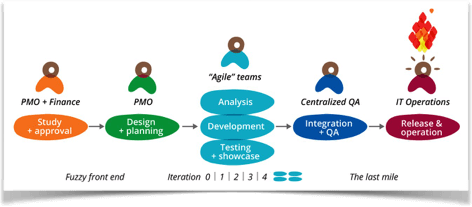 There is no question that Agile is one of the top project management approaches these days and even littler question of it going away anytime soon. However, as more and more people start adopting the iterative practices, more innovations and modifications of them start to appear. Agile methods are being mixed together, redefined, scaled and in this particular case joined together with a completely different school of thought.
There is no question that Agile is one of the top project management approaches these days and even littler question of it going away anytime soon. However, as more and more people start adopting the iterative practices, more innovations and modifications of them start to appear. Agile methods are being mixed together, redefined, scaled and in this particular case joined together with a completely different school of thought.
WaterScrumFall aims to breach the gap between two worlds, but does it succeed?
To put it simply, the hybrid approach joins together the linear Waterfall and the circular Agile methods to find a happy medium and the best of both approaches called the WaterScrumFall. The name looks a little heavy at the first glance, but it absolutely makes sense with the way the method is set up. Waterfall approach is used at the beginning and ending stages of the project, while the Agile (usually Scrum) approach is sprang into action right in the middle. Therefore we have it Water – Scrum – Fall, depicting the way hybrid projects are run.
The division
This structure makes sense when you think about most of the corporations and the way they react to change. Most of the companies are reluctant to switch up processes at large, however they can be easily changed in small teams, especially in the operational level. WaterScrumFall takes advantage of that – the activities that require more budgeting, planning and are related to higher management positions remain with the waterfall approach, while the execution is switched to Agile.
Let’s say an average project is composed out of 5 stages – Study/Requirements, Design/Planning, Implementation, Verification/Testing and Release/Maintenance. The first two stages require quite a bit of knowledge and analysis to make sure the project runs smoothly and thus are completed by the upper and higher management. This makes a shift to Agile difficult and the stages remain in the Waterfall methodology. Next comes the build stage that requires teams to create the products based on the laid out plan. On this operational level, making changes is much easier, thus Scrum practices are introduced. Lastly, the resulting products have to be tested and maintained, which requires developed processes and a good overall understanding. This once more makes Agile adoption a little more tricky and the waterfall practices are used instead.

This way WaterScrumFall uses both approaches in places where they are the most comfortable for the company. Starting with Scrum on the operational level allows teams to evaluate its value and scale it at the pace they feel comfortable with. Thus avoiding rejection and misconceptions within the organization.
Two opinions
There are two schools of thought when it comes as to why the hybrid approach is necessary, but both deal with the same issue – implementing Agile practices in large organizations. The first opinion group claims that WaterScrumFall should be used as a stepping stone for companies reluctant to adopt Agile organization wide right off the bat. It sees it as a good way to start implementing Agile on a small scale and then increase gradually. Others claim that while Agile is very beneficial in the production stages, large companies simply will not benefit from a full Agile transition. Thus the hybrid approach is a great way to get the best of both worlds and keep both methods at their most suitable stages.
Whichever opinion you support, WaterScrumFall is a great way to test out Agile practices in any Waterfall company and see whether it has any potential to increase the business results in a positive way. At the same time it does not completely disregards the positives of waterfall and allows you to enjoy both methods.
Similar school of thought has been used in mixing Agile with PRINCE2, which proved to be a great solution for some. Therefore, as I always say – don’t be scared to break the rules of Agile it may bring you the best results.




